Perfect Pond Landscaping: Design Tips & Maintenance Tricks
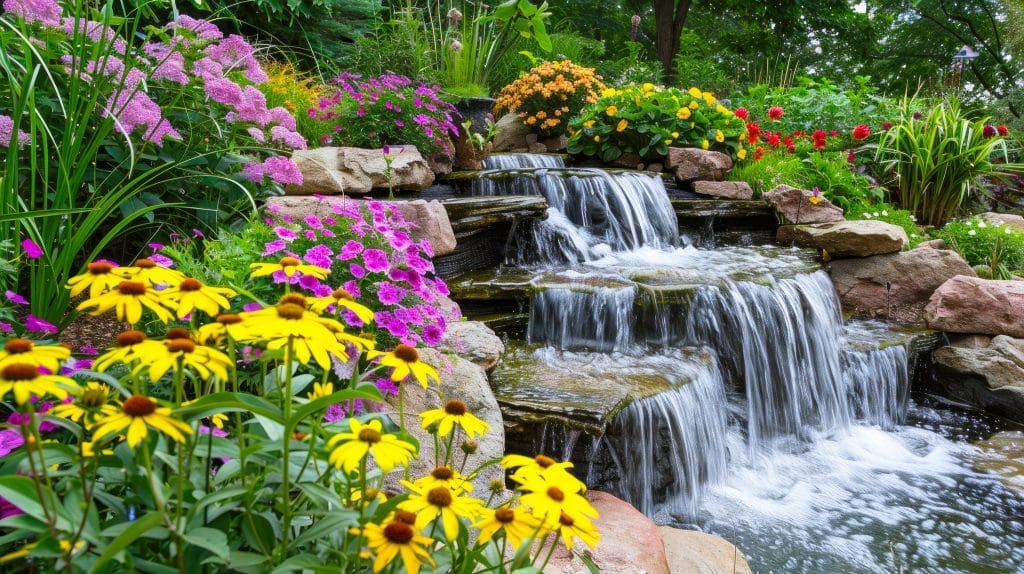


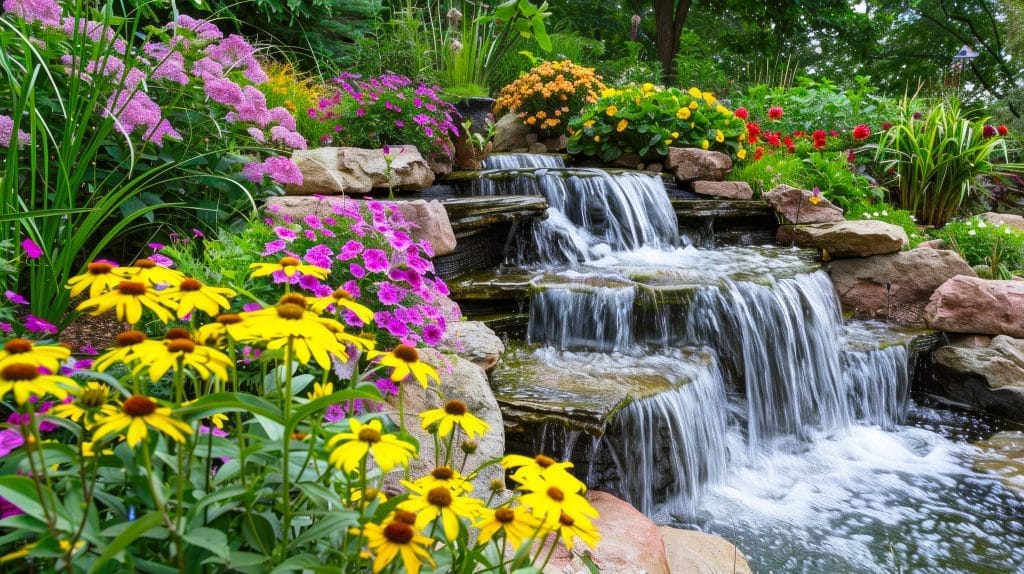
Perfect Pond Landscaping: Design Tips & Maintenance Tricks
Want to create a stunning pond in your garden? This article covers everything you need to know about pond landscaping, from choosing the right pond type and materials to practical design tips and maintenance tricks to keep your pond beautiful and healthy.
Key Takeaways
- Pond landscaping enhances aesthetic appeal and ecological value, requiring careful selection of materials and design styles such as informal or formal ponds.
- Incorporating diverse aquatic and marginal plants is essential for maintaining ecological balance, supporting wildlife, and achieving a natural look around the pond.
- Regular maintenance, including seasonal tasks and algae control, is crucial for the health and longevity of a garden pond, ensuring a thriving ecosystem.
Understanding Pond Landscaping
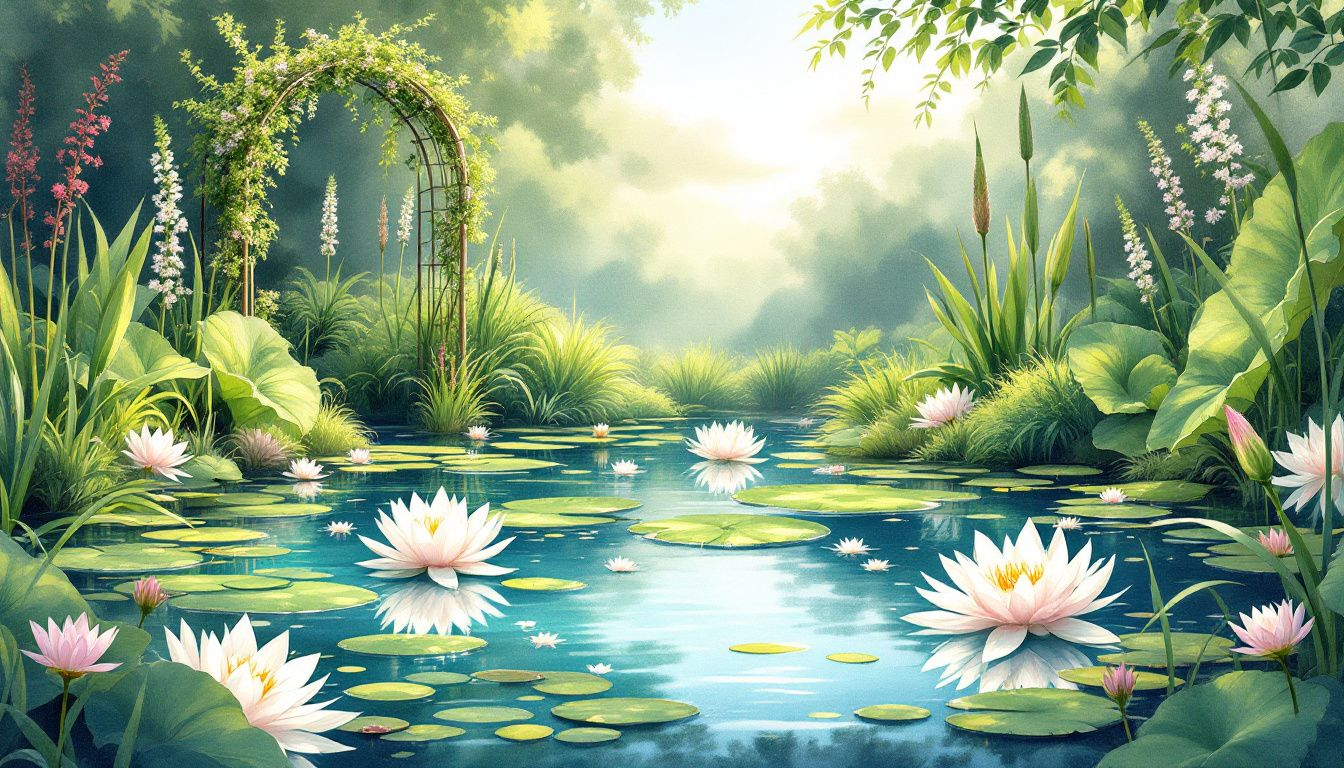
Pond landscaping is more than just a decorative addition; it is a thoughtful integration of 490 that enhance the overall aesthetic and ecological value of your garden. A garden pond can break your backyard into defined sections, creating a structured feel that is both pleasing to the eye and beneficial for wildlife. Using ecologically sourced materials ensures your pond remains sustainable and environmentally friendly.
Creating the perfect pond requires selecting the right materials and tools, such as a shovel for excavation to maintain gentle slopes and remove debris. The key to a successful pond design lies in understanding the various types of garden ponds and choosing the appropriate pond liner to ensure longevity and functionality.
Types of Garden Ponds
When it comes to garden ponds, there are two main styles to consider: informal, natural-looking ponds and symmetrical, formal pond. Informal ponds, with their gently curving edges, blend seamlessly with the natural landscape, creating a serene and organic feel. Formal ponds, on the other hand, are characterized by their symmetrical shapes and structured appearance, making them ideal for contemporary garden designs.
Within these styles, there are various types, such as cyclical ponds, which are loosely oval-shaped and run in a ring with solid ground in the center, and hexagonal ponds that suit modern garden aesthetics. Raised pond is perfect for paved areas, and pre-formed ponds made from high-density polyethylene (HDPE) offer a quick and easy installation option.
Choosing the Right Pond Liner
Selecting the right pond liner is crucial for the durability and functionality of your garden pond. HDPE pond liners are highly recommended due to their strength and flexibility, making them a popular choice for various pond designs. Alternatively, butyl liners offer the flexibility to create naturally shaped ponds, allowing for more creative and organic designs.
Extend the pond liner at least 50 cm beyond the top of the pond to allow for proper anchoring with rocks or bricks. This keeps the liner in place and maintains the pond’s shape. Carefully remove small stones or debris from the excavation site to prevent liner damage and ensure a smooth installation.
Designing Your Perfect Pond
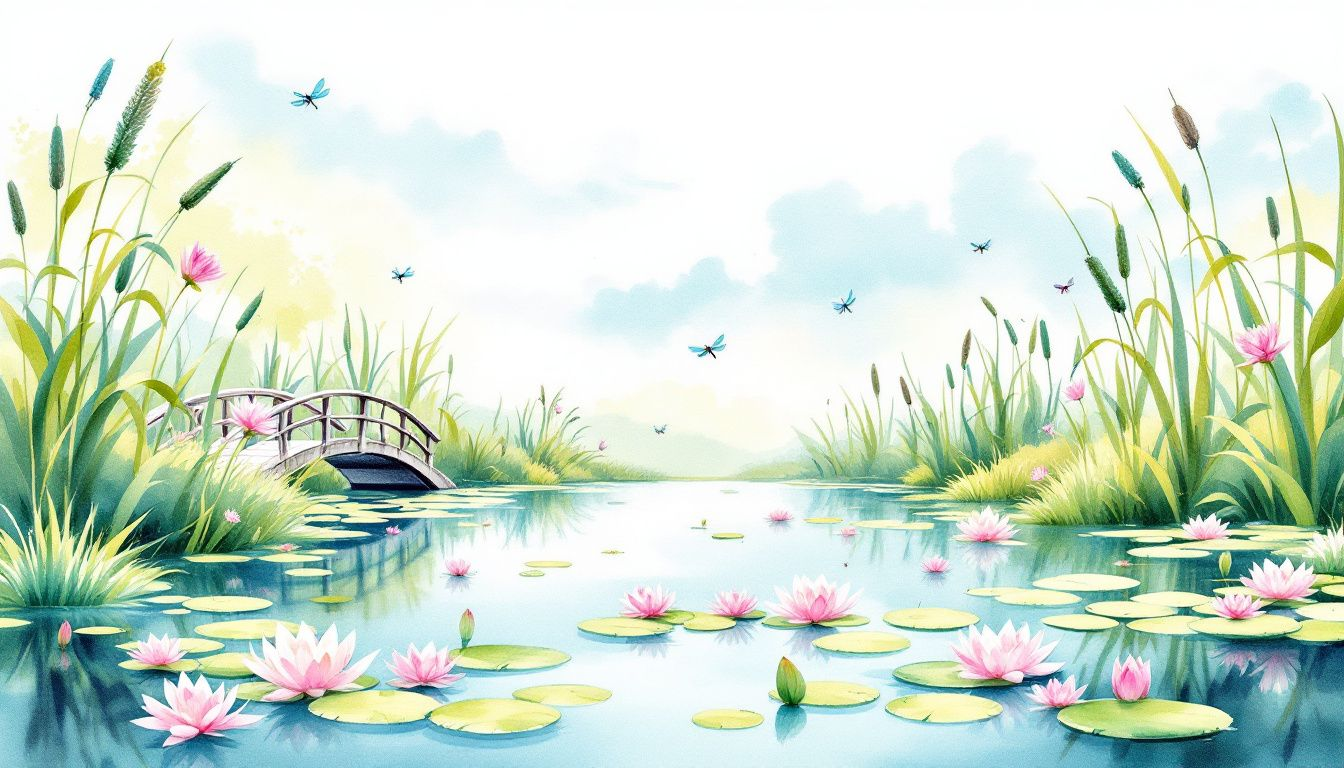
Designing a garden pond involves careful planning and consideration of various elements to create a harmonious and functional water feature. Key factors include the depth, size, shape, and location of the pond, as well as detailed plans for planting areas and filtration routes. Incorporating hard landscaping elements, such as stones and pathways, can enhance both the usability and aesthetic appeal of your pond.
Lighting is another key component to consider during the design phase, simplifying installation and significantly enhancing the overall look of your pond. Strategic lighting highlights the pond and creates a captivating focal point within your garden.
This section will guide you through selecting the right pond shape and size, incorporating 490, and creating a natural look.
Selecting Pond Shapes and Sizes
Choosing the shape and size of your garden pond depends on available space, desired aesthetics, and functionality. Even a small pond can accommodate a garden, offering a tranquil retreat within limited space. A smaller pond can also be an option for those with less room. Multi-level ponds, with two levels and a flow between them, add visual interest and can be an attractive feature in larger gardens.
Experiment with different shapes and positions using tracing paper over your garden plan to visualize how various pond designs will fit into your landscape. Whether you choose a simple geometric shape or a more complex design like a bridged pond, the key is to integrate the pond seamlessly into your garden’s overall design.
Incorporating 490
490 such as fountains, streams, and layered elements can transform a garden pond into a serene and captivating focal point. Running 490, like streams, not only enhance the auditory experience but also add movement and life to your pond. Flowing water in multi-level ponds with waterfalls creates delightful sounds and adds dimension to your garden.
Incorporate a layered water feature to increase both visual interest and sound within your garden for a more immersive experience. These features can suit various pond styles, from formal to naturalistic, making them a versatile addition to any outdoor space.
Creating a Natural Look
Integrating your pond seamlessly into your landscape enhances both its aesthetic and ecological value. Aquatic planting is key to achieving this naturalistic style, with plants like lily pads serving both decorative and ecological purposes. These plants add beauty and structure to the pond while supporting local wildlife.
Incorporating a mix of sun and shade around your pond helps to create a balanced environment that attracts a diverse range of species. Carefully selecting and placing aquatic plants and other natural elements helps create a pond that blends harmoniously with your garden while providing a thriving habitat for wildlife.
Planting Around Your Pond
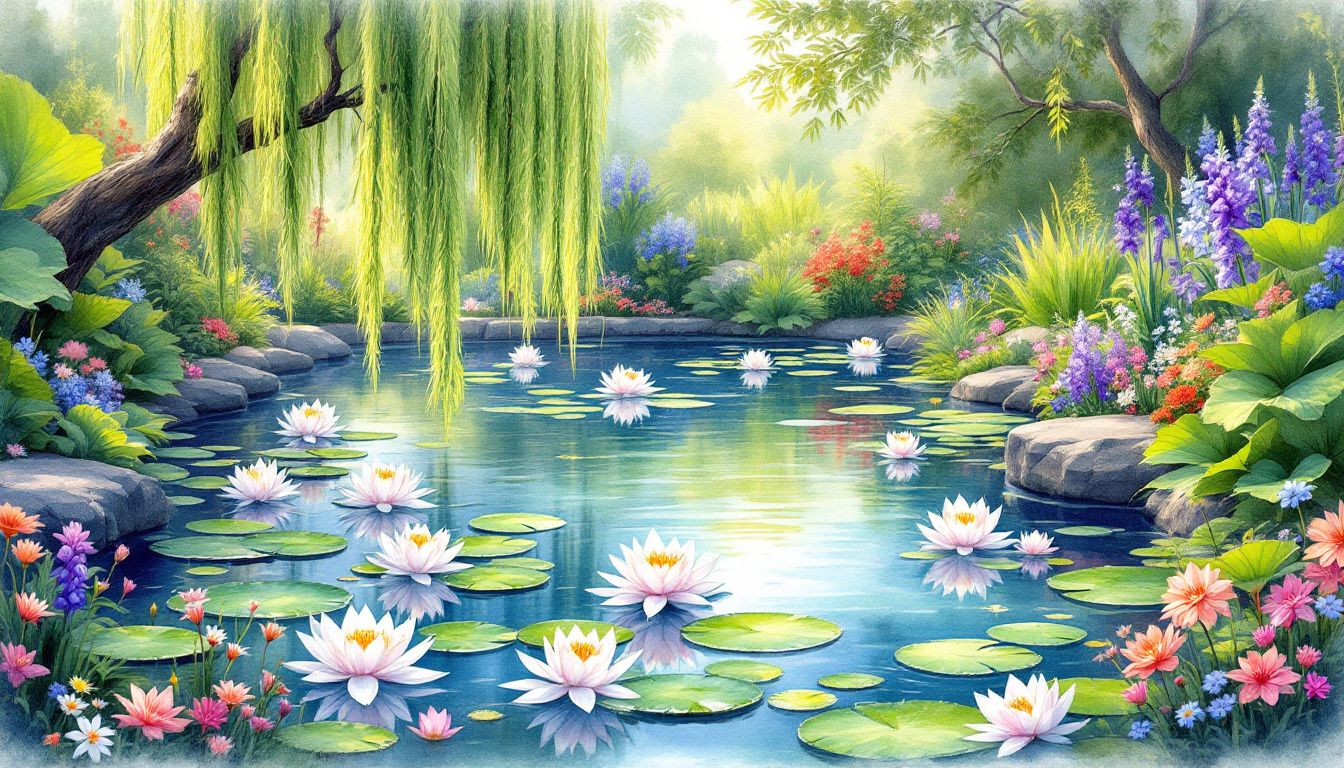
Plants play a crucial role in the overall health and aesthetics of your garden pond. A diverse selection of flowering and foliage plants can enhance the beauty of your pond while providing essential habitats for wildlife. The right combination of plants can also help maintain a natural look and integrate your pond seamlessly into your garden.
For a thriving pond, choose plants that can withstand heavy pruning and maintain their appearance throughout the year. This section will cover the different types of plants suitable for pond environments, including aquatic plants, marginal and bog plants, and native plants for wildlife.
Aquatic Plants for Your Pond
Aquatic plants are vital for the ecological balance of your garden pond. They compete with algae for nutrients, helping to keep the water clear and healthy. Plants like lily pads add beauty and structure, creating a serene and visually appealing environment.
Submerged plants support pond life, such as dragonfly larvae, which require these plants for development. A mix of sun and shade creates an inviting habitat for various aquatic species, including spawning frogs.
Marginal Plants and Bog Plants
Marginal plants, which grow along the edges of the pond, play a crucial role in stabilizing the pond’s banks and providing habitats for wildlife. These plants, along with bog plants, help soften the overall appearance of the pond and create a more natural transition to the surrounding landscape.
Strategically placing these plants around a minimalist pond maintains clean lines and a simple aesthetic while still supporting the pond’s ecological health. Choosing a variety of marginal and bog plants enhances both the visual appeal and functionality of your pond.
Native Plants for Wildlife
Using native plants in your pond landscaping is an effective way to attract local wildlife and create a balanced ecosystem through wildlife gardening. Indigenous plants are well-adapted to the local climate and soil conditions, making them easier to maintain and more beneficial for local fauna.
Incorporating various pond depths and habitats, such as gravel beaches and dense shrubs, provides safe access and shelter for wildlife. Using native plants creates a wildlife-friendly pond that supports a diverse range of species and contributes to the overall health of your garden ecosystem.
Hard Landscaping Elements
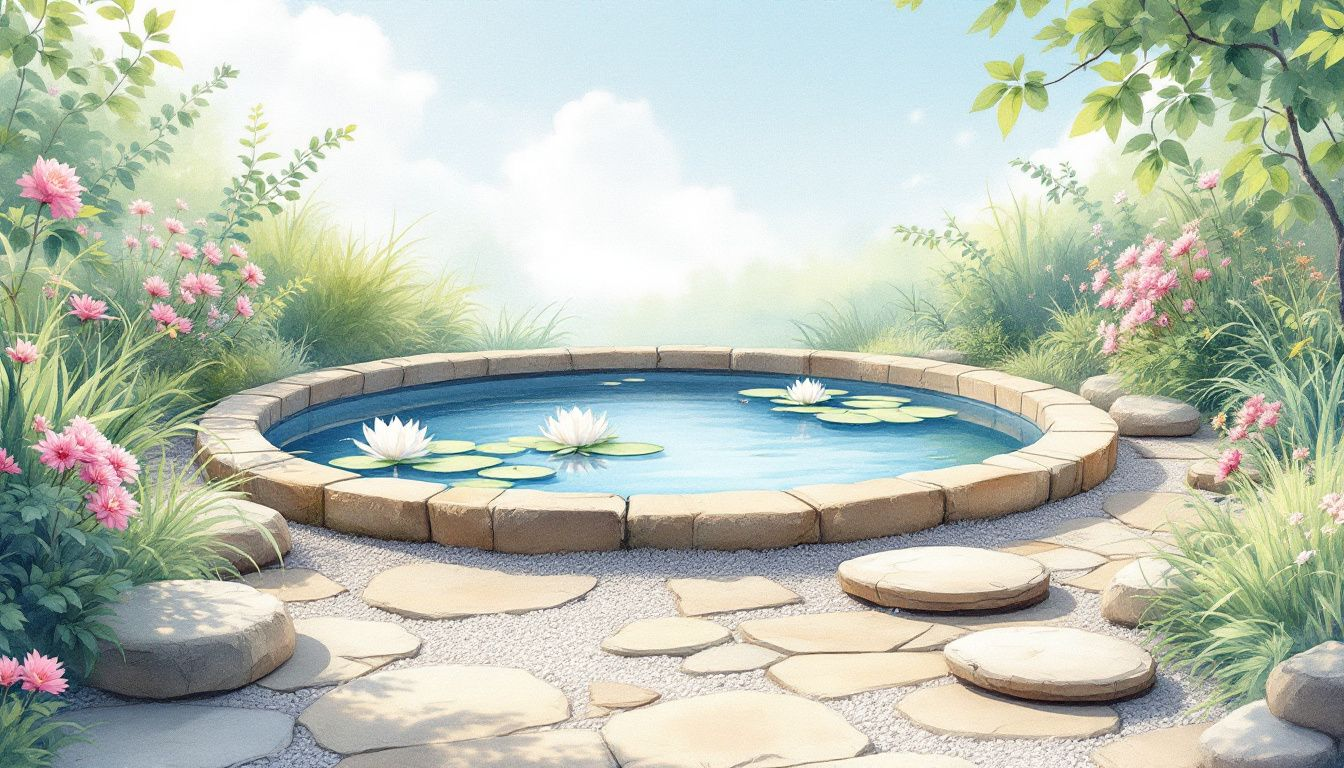
Hard landscaping elements add structure and visual interest to your garden pond, enhancing both its functionality and aesthetic appeal. Natural materials like rustic stones and varied textures can create a harmonious and visually engaging pond landscape, as landscape gardeners often recommend.
Incorporating these elements strategically around your pond can help define its boundaries and create a seamless transition to the surrounding garden. This section explores the use of edging and decorative stones, as well as pathways and bridges, to enhance your pond’s design.
Edging and Decorative Stones
Using various stones for edging and decoration creates visual interest and defines the boundaries of your garden pond. Smooth stones provide a polished look, while cobblestones and rounded rocks help disguise the pond liner and create a natural transition to the landscape.
Mixing different sizes and textures, such as combining smooth and rough stones, enhances the natural appearance of the pond edges and adds depth to the overall design.
Whether you prefer a clean, modern look or a more rustic, natural style, the right choice of stones can significantly enhance your pond’s aesthetics.
Pathways and Bridges
Pathways and bridges improve accessibility while adding a charming and functional element to your pond landscaping. Natural materials like stepping stones can harmonize with the overall garden design, creating a cohesive and visually appealing pathway.
Bridges, whether simple or elaborate, can enhance the visual interest and provide a unique vantage point to view your pond and its surroundings. Carefully integrating pathways and bridges into your pond design creates an inviting and accessible outdoor space that encourages exploration and enjoyment.
Pond Maintenance Tips
Regular maintenance keeps your garden pond healthy and beautiful. A maintenance schedule helps prevent serious issues and ensures the longevity of your pond. Regular water testing and maintaining optimal water conditions are crucial for the health of the pond and its inhabitants.
A well-maintained pond looks better and provides a healthier environment for aquatic plants and wildlife. This section covers important maintenance tasks, including seasonal maintenance, algae control techniques, and the use of pond pumps and filtration systems.
Seasonal Maintenance Tasks
Seasonal maintenance is crucial for the longevity and health of your pond. In spring, removing debris and checking the health of pond plants ensures a good start to the growing season. Seasonal tasks keep your pond in top condition throughout the year, addressing different needs during winter, summer, and other seasons.
Following a seasonal maintenance routine helps prevent problems before they arise and ensures your pond remains a thriving feature in your garden. Regularly updating your maintenance plan based on seasonal changes keeps your pond ecosystem balanced and healthy.
Algae Control Techniques
Managing algae growth is a common challenge in maintaining a garden pond, but it can be effectively controlled with the right techniques. Regularly removing floating weeds and algae, especially during warm conditions, prevents overgrowth. Enhancing water circulation by regularly cleaning filters and using pond pumps reduces algae proliferation.
Submerged plants help manage algae by providing oxygenation and competing for nutrients. These plants support overall pond health and contribute to a balanced, aesthetically pleasing water garden.
Implementing these algae control techniques helps maintain clear and healthy pond water throughout the year.
Pond Pump and Filtration
Pond pumps and filtration systems are essential for maintaining the clarity and health of your garden pond. A pump ensures adequate water flow, especially in features like a half-sunken pond or a multi-level water feature. Choosing the right pump size provides sufficient water circulation to maintain a balanced ecosystem.
Understanding water chemistry keeps your pond water clear and free of harmful substances. Regular maintenance of your filtration system ensures it functions effectively, keeping the water clean and safe for aquatic plants and wildlife.
Incorporating accessories like lighting and filters during the pump installation enhances both the functionality and aesthetics of your pond.
Enhancing Your Pond with Wildlife
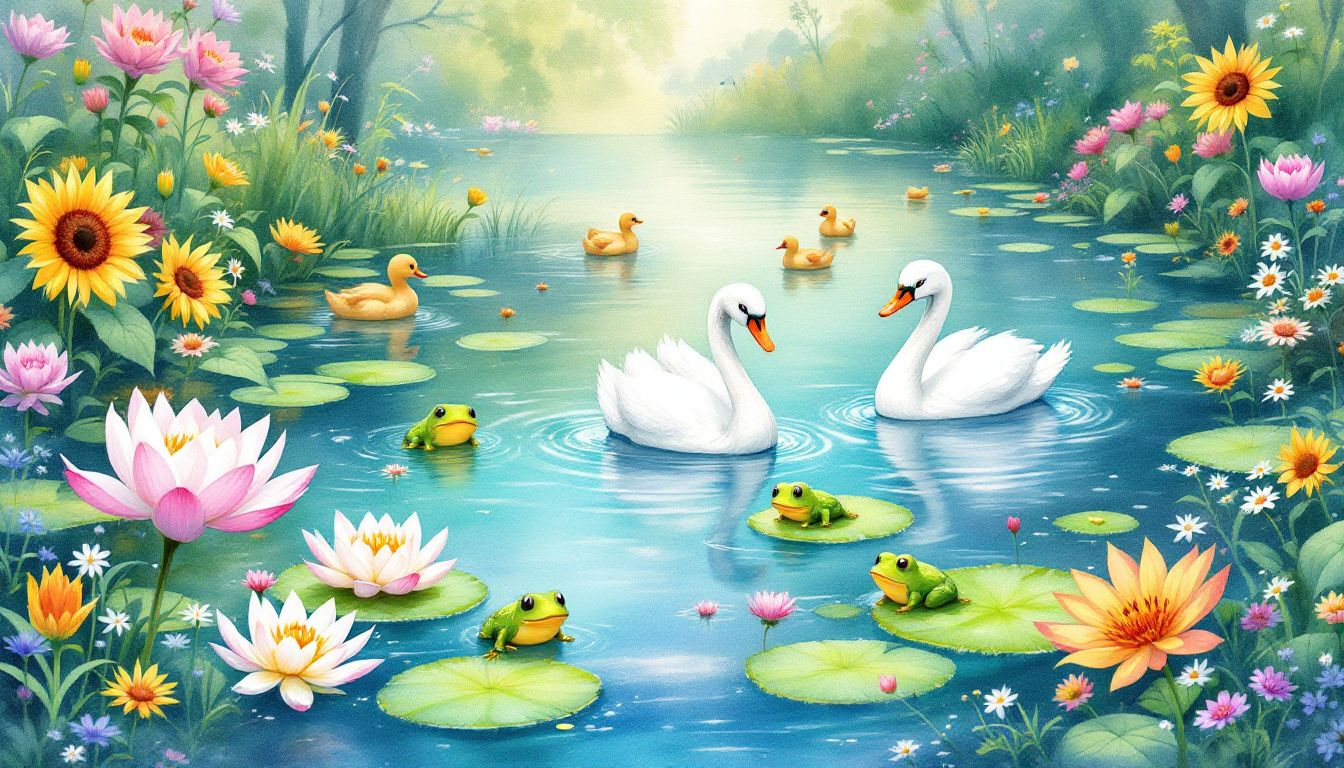
Enhancing your pond with wildlife adds to the beauty of your garden and creates a thriving ecosystem. A pond with sloping sides supports wildlife by providing easy access and a damp habitat for various species. Adding gravel and stones along the pond’s edge creates habitats for different animals, enriching the biodiversity of your outdoor space.
Regular checks on pond plants and water quality maintain a healthy ecosystem that supports frogs, toads, newts, and insects. Creating adjacent habitats and allowing grass to grow along one pond edge enhances wildlife movement and supports a diverse range of species.
This section focuses on specific ways to attract pond skaters and frogs, as well as creating shelters and hiding spots.
Attracting Pond Skaters and Frogs
To attract pond skaters and frogs, create an inviting habitat with shallow areas, rocks, and plants for basking and hiding. Clean, well-oxygenated water with minimal pollution creates a conducive environment for these creatures. A variety of aquatic plants provides shelter, food, and breeding sites for frogs and other beneficial creatures.
Adding rocks, logs, or shallows around the pond offers safe zones for frogs to retreat from predators and for pond skaters to rest. Providing the right conditions and habitat features attracts a diverse range of wildlife to your garden pond, enhancing its ecological value and natural beauty.
Creating Shelters and Hiding Spots
Creating shelters and hiding spots in your pond landscape provides safe havens for wildlife. Frogs benefit from sheltered plant areas in ponds, which provide shade and protection from predators. Incorporating dense shrubs, tall grass, and other cover around your pond creates a secure environment for various species.
These shelters enhance the habitat for wildlife and add to the natural aesthetics of your pond. Using natural materials like logs and rocks or planting dense vegetation to create these safe zones ensures your pond remains a thriving and wildlife-friendly feature in your garden.
Lighting and Aesthetics
Lighting enhances the aesthetics of your garden pond, creating an inviting atmosphere and transforming it into a captivating focal point during nighttime. Creative lighting options, such as submerged lights and spotlights, highlight specific pond features and enhance the overall beauty of your outdoor space.
Adding decorative elements like sculptures, plantings, and ornaments near the pond further enhances its visual appeal. Carefully selecting and placing these elements personalizes your pond and reflects your unique style, making it a standout feature in your garden.
Pond Lighting Options
Various lighting options are available for illuminating your garden pond, each offering different benefits and aesthetic effects. Solar-powered lights are an eco-friendly and cost-effective option, providing illumination without increasing your energy bills. Colored LEDs can add a vibrant touch and alter the mood of the pond area, creating a magical ambiance at night.
When selecting pond lighting, consider factors such as energy efficiency, desired ambiance, and installation ease. Proper lighting enhances the aesthetics of your water feature, making it a stunning focal point in your garden during the evening hours.
Decorative Elements and Ornaments
Incorporating decorative elements and ornaments can add character and personality to your garden pond. Elements such as stone turtles, decorative pagodas, water mills, and waterfalls can create a unique and charming atmosphere. Utilizing tropical, exotic, and foliage plants also serves as decorative features that enhance the pond’s design.
To avoid overwhelming the pond space, focus on neutral colors and give preference to foliage plants instead of flowering ones. Incorporating floating decorations like lily pads or ornamental floats can further enhance the visual interest of the pond, creating a serene and aesthetically pleasing environment.
Summary
In summary, creating the perfect garden pond involves careful planning, design, and maintenance. Understanding the different types of ponds and choosing the right materials are crucial first steps. Designing a pond that fits your space and aesthetic preferences, incorporating 490, and planting the right vegetation all contribute to a beautiful and functional pond.
Regular maintenance, including seasonal tasks, algae control, and proper pump and filtration systems, ensures your pond remains healthy and vibrant. Enhancing your pond with wildlife and adding lighting and decorative elements further elevates its beauty and ecological value. By following these tips and tricks, you can transform your garden into a tranquil oasis that brings joy and relaxation for years to come.
Frequently Asked Questions
What are the benefits of adding a garden pond to my backyard?
Adding a garden pond significantly boosts the aesthetic appeal of your backyard while providing a habitat for wildlife and creating a tranquil atmosphere for relaxation throughout the year. It enriches your outdoor space in multiple ways.
What types of pond liners are best for my garden pond?
HDPE and butyl liners are the best options for your garden pond, as they offer strength, flexibility, and the ability to create naturally shaped designs. These liners will help ensure the longevity and aesthetic appeal of your pond.
How do I control algae growth in my pond?
To control algae growth in your pond, regularly remove floating weeds and algae, enhance water circulation, and introduce submerged plants. These actions will create a healthier environment and minimize algae proliferation.
What are some lighting options for my garden pond?
Consider using solar-powered lights, colored LEDs, or traditional electric lights to beautifully illuminate your garden pond and enhance its nighttime ambiance. Each option offers unique benefits that can elevate the overall aesthetic of your outdoor space.
How can I attract wildlife to my garden pond?
To attract wildlife to your garden pond, create shallow areas, include rocks and plants, and ensure the water is clean and well-oxygenated. Incorporating native plants will further enhance biodiversity in your pond.

Frequently Asked Questions
MY POND IS OVERGROWN.
MY POND IS LEAKING – WHAT CAN I DO?
WHY IS MY POND WATER GREEN?
Do I need to have my pumps running all the time?
Why Choose Us
Experience With years of experience in pond maintenance and cleaning, our team has the expertise to handle ponds of all sizes and complexities. We are dedicated to delivering high-quality services tailored to meet the unique needs of each customer.
Professionalism Our team consists of trained professionals who are passionate about pond care. We take pride in our work and strive to exceed our customers’ expectations with every service we provide.
Customized Solutions We understand that every pond is different, and we tailor our services to suit the specific requirements of each customer. Whether you have a small backyard pond or a larger water feature, we have the knowledge and resources to keep it in pristine condition.
Environmentally Friendly Practices We are committed to using eco-friendly products and methods in our pond cleaning services. Our goal is to promote sustainability and preserve the natural balance of your pond ecosystem.
Customer Satisfaction Your satisfaction is our top priority. We work closely with our customers to ensure that their pond maintenance needs are met with professionalism and care. We take the time to listen to your concerns and provide personalized recommendations to help you achieve the pond of your dreams.
Ready to schedule a pond cleaning service with us?
Contact Aqua Pond today to learn more about our services and to book an appointment.
Let us help you create a clean, healthy, and vibrant pond that you can enjoy for years. Thank you for considering Aqua Pond for your pond maintenance needs.
What our Customers Say...
